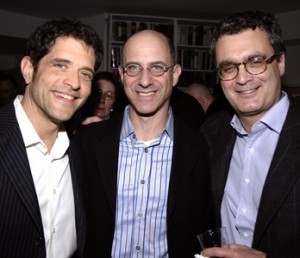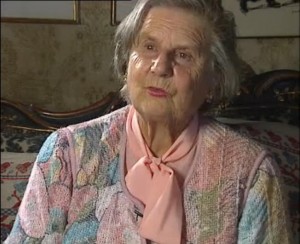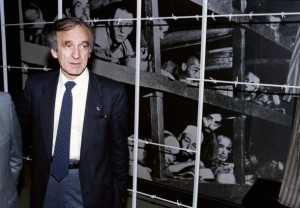Night #1 and Night #2—What Changes were Made and Why, Part Two
Wednesday, March 7th, 2012
By Carolyn Yeager
copyright 2012 Carolyn Yeager
Elie Wiesel questioned under oath in a California courtroom in 2008:
Q. And is this book Night that you wrote a true account of your experience during World War II?
A. It is a true account. Every word in it is true.
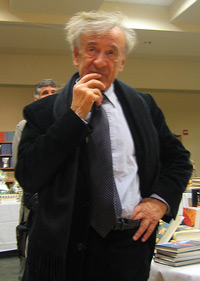
Elie Wiesel manning his table at a Jewish book fair in Austin, TX, 2006. The new translation of Night by his wife Marion had come out in January of that year, and it was immediately chosen for Oprah Winfrey’s book club.
In Part One, I established that the decision to rebrand Night into an autobiography was the reason for a new translation, in which necessary changes could be made to better ‘fit’ the story both to the real Elie Wiesel and the known facts of the Hungarian deportation.
When the 2006 translation came out, with its new classification to “autobiography,” questions arose from some circles. Responding to these questions, Edward Wyatt wrote an article in the NewYork Times on Jan. 19, 2006, in which he quoted Jeff Seroy, senior vice president at Farrar, Straus & Giroux, parent company of Night publisher Hill & Wang, as strongly denying that changes were made to bring the book more in line with the facts. “Nonsense,” said Seroy. “Some minor mistakes crept into the original translation that were expunged in the new translation. But the book stands as a record of fact.”
Blaming the Translator
“Mistakes in the original translation” can only mean mistakes by Stella Rodway, the original translator! But we have already shown that Stella Rodway faithfully reproduced the French La Nuit, which was Wiesel’s own work. The author and publisher are casting these changes as translation errors to divert attention away from Elie Wiesel’s own errors—part of their campaign to pass Night off from now on as “a record of fact.”
A record of fact it isn’t
When I ended Part One, Eliezer and Father were still in the train car on their way to Buchenwald. You will recall that the Yiddish, the French and thus the original English version of Night specified the trip took 10 days and 10 nights from Gleiwitz (on the former German/Polish border) to Buchenwald. Since we know from standard historical sources1 that the prisoners were evacuated from Monowitz on Jan. 18 and arrived in Gleiwitz the next day, Jan. 19; and since according to the description in Night itself, they spend three days in Gleiwitz (Jan. 20-22), this would make their day of arrival February 1, 1945. But in Night, Father’s death takes place the night of Jan. 28-29, three days before they arrived! This is why Marion Wiesel removed the number 10 in her new translation, leaving the number of days and nights undetermined.
A strange detail that actually belongs in Part One is on page 87 of the original Night. Eliezer remarks, after his and his Father’s deliberations and final decision to go on the march: “I learned after the war the fate of those who had stayed behind in the hospital. They were quite simply liberated by the Russians two days after the evacuation.” The evacuation, as we all know, was on the 18th. We also know the Russians did not arrive on the 20th of January! The actual liberation day is January 27. What possessed Wiesel to write this? Well, because it was in Un di velt: “Two days after we had left Buna, the Red Army occupied the camp. All the sick had stayed alive.”
From the point in the story of Eliezer and Father’s arrival at Buchenwald there are no significant changes made by Marion Wiesel to the original French and English versions. But there is much in all the versions that differs strikingly from the “official holocaust history” as written by acknowledged official chroniclers such as Danuta Czech. So I will continue with comparisons between Night and “official history,” along with some very significant changes made from Un di velt hot geshvign to Wiesel’s edited French La Nuit.
Arrival at Buchenwald: 26 Jan. or 1 Feb.?
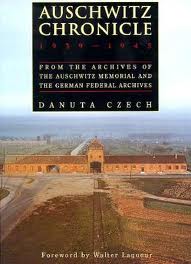 Danuta Czech, in her Auschwitz Chronicle1, records that on January 26,
Danuta Czech, in her Auschwitz Chronicle1, records that on January 26,
A transport with 3,987 prisoners from Auschwitz auxiliary camps reaches Buchenwald. There are 52 dead prisoners in the transport. 115 prisoners die on the day of arrival. Their corpses are delivered to the autopsy room. (P 801)
This is the transport that carried Lazar and Abraham Wiesel/Viezel, Miklos (Nikolaus) Grüner and all of the inmates of Monowitz whose names are on the transport list.2 According to Czech, the Monowitz prisoners began their march on the evening of January 18, 1945, with “divisions of nurses placed between the columns” of 1000 each (P 786), arriving at Gleiwitz Camp the following evening. On Jan. 21 “they are loaded in open freight cars with other prisoners from Auschwitz who have arrived in Gleiwitz.” (P 788) From Jan. 21 to Jan. 26 is five days of travel … not ten, as Wiesel wrote in Night.
The narrative in Night gives us a date of Jan. 22 for the boarding of the train, one day later than Czech. And while Night gives the number of days on the train (10), it does not name the date of arrival.
Hilda Wiesel says her father died on arrival
Totally contradicting what is written in Night, Hilda Wiesel Kudler, Elie’s oldest sister, in her testimony for the Shoah Foundation in 1995, said she learned from her brother that their father died as he stepped off the train.
And I said, where is father? And he replied, he’s gone back to Sighet; he[Elie] didn’t want to tell me [that he was dead]. And I repeated, but where is he? And he insisted he was at Sighet. And I said, look, I want you to tell me the truth. Because he knew the date of my father’s death. You know, they did a long march3 from Auschwitz, then they put them on the train to go to Buchenwald; he died gasping for air; when he stepped off the train, he died gasping for air; at Buchenwald. But he[Elie] knew the date.
From this, we can better understand something about Elie Wiesel—that he has never had a problem with making up stories that “sound better” than the truth. But, if Hilda is correct in her recall, and if their father really was one of the 115 inmates who Danuta Czech reports died on the day of arrival, then Wiesel’s long, melodramatic story of watching his father sicken and die over a ten-day period in Night is fiction. All of it—including his father being whacked on the head by a cruel “officer” in the barracks.
The day of arrival for this transport is Jan. 26, but according to the timeline in Night, it arrives on Feb. 1. Either way, it doesn’t correspond to the date of Jan. 28 that Wiesel, for reasons unknown, selected as the date his fictional Father died.
You might also be interested to know that Hilda is named Deborah in Un di velt; the name Hilda is never used. It was Wiesel who changed it to Hilda in La Nuit.
Un di Velt says Father dies a week after arrival in Buchenwald, Night says 8-10 days … yet it is January 28 … or is it the 18th Day of Shevat?
Regular readers of this blog will know this already, but it bears repeating yet again: there is no Shlomo Wiesel in the official history or in the records who fits the profile of “Father” as described by Elie Wiesel in Night. There is an Abraham (sometimes shortened to Abram) Viezel who is recorded in several places—on a medical report at Auschwitz, on the transport to Buchenwald, and on a death certificate dated Feb. 2, 1945, seven (7) days after arrival. This Abraham was born Oct. 10, 1900, making him 44 years old when he died. Recall that Night gives Father’s age as 50 in 1944 (SR, P 40).
Wiesel’s description has the transport to Buchenwald arriving on Feb.1st. But that’s just the beginning. After arriving, this is the timeline given in both the original Night and Marion Wiesel’s 2006 translation:
It was daytime when I awoke. I went to look for my father. (Feb. 2nd)
[…]
On the third day after our arrival at Buchenwald, everyone had to go to the showers [his father went too-cy]. Even the sick who had to go through last. (Feb 4th) […] Struck down by dysentery, my father lay in his bunk, five other invalids with him. I sat by his side watching him … A week went by like this. (Feb. 11th or Feb. 8th depending on how you read it)
[ . . . ]
When I got down after roll call, I could see his lips trembling as he murmured something. […] Then I had to go to bed. I climbed into my bunk, above my father, who was still alive. It was January 28, 1945. (still Feb. 8 or 11) I awoke on January 29 at dawn. In my father’s place lay another invalid. They must have taken him away before dawn and carried him to the crematory.” (Feb 12th or 9th) [Stella Rodway translation, pp 107-112]
The timeline in Un di velt is not in doubt:
On the seventh or eighth day of our being in Buchenwald, the bunk-elder [should be block-elder -cy) who used to deal out bread for the whole bunk [sic], came to me. . . .
[ . . . ]
On the same day, in the evening, disaster struck. The end. During roll call. The healthy had to go out of the block in order to be counted by the S.S. men. The sick stayed in their bunks. My father and I thus stayed inside. He — because of his dysentery and I — because of my bandaged foot. Father was lying in the lowest bunk and I — in the uppermost.
[ . . . ]
After roll call, I immediately jumped down from the uppermost bunk and ran to him. He was still breathing. But — he was silent.
[ . . . ]
For a couple of hours I stayed by him and looked at his face long and well […] Then they forced me to go lie down to sleep. I climbed up to the uppermost bunk and I did not know that in the morning, on awakening, I would find my father no more.
It was the eighteenth of Shevat, 5705.
* * *
Nineteenth of Shevat. Early in the morning.
I got up and ran to my father. Another sick man was lying in his place.
I had a father no more. (pp 233-238)
Readers might be surprised to learn that the Hebrew calendar date of 18-19 Shevat, 5705 corresponds to February 1-2, 1945! How neat is that? So, in Un di velt Father dies seven days after arrival, on the very same day as Abraham Viezel died, who was officially recorded at Buchenwald with the registration number of 123488 and the Auschwitz registration number of A-7712. (However, Un di velt also says that the trip from Gleiwitz to Buchenwald took ten days, which means they could not have arrived until sometime in February. Seven days from that time would not be Feb. 2nd.)
So can we conclude from this that Abraham is Shlomo? Not necessarily. The Yiddish author reports Father’s death as occurring during the night of 18-19 Shevat (Feb. 1-2), but Elie Wiesel, author of La Nuit, says the date is Jan. 28th! Why? Who can answer that but Elie Wiesel? He certainly knows what the month of Shevat and the year 5705 means … or he could have easily found out.
Or can we conclude that Un di velt was written by Lazar Wiesel, as Nikolaus Grüner claims … that he wrote his story as a father-son relationship … and that he was perhaps not the brother of Abraham as Grüner says he was? (It’s noted on Lazar’s Buchenwald file card that his father was also in Buchenwald; his mother in Auschwitz.) Well, again, not necessarily. There are other possibilities. But I’m getting ahead of myself.
The facts are, there are problems with all of these theories; none is a perfect fit. We can ask: If Elie Wiesel is the author of Un di velt hot geshvign, why did he change so many of the underpinning facts of the story when he rewrote it in French as La Nuit? This is a real head-scratcher. We can also ask: Why did Naomi Seidman, the Jewish professor who discussed in detail some of the differences between the Yiddish book and Night, not mention the 18th of Shevat? Is it because she couldn’t find an explanation for it? Siedman, Ruth Franklin and other Jewish reviewers have never brought up some of these Yiddish to French discrepancies. They are too embarrassing a problem for them.
What we can safely say is that no matter who the author of Un di velt was … he was totally unfamiliar with the real facts of when the Monowitz prisoners arrived at Buchenwald. Was it because he was not one of them? Was it because he was not concerned about accuracy since his story was directed at a non-critical audience—a Yiddish-speaking Jewish audience? As we continue, we’ll find more mystifications, but also a few certainties.
What happens to Eliezer after Father’s death?
Wiesel writes in Night (essentially the same in all translations):
I had to stay at Buchenwald until April eleventh. I have nothing to say of my life during this period. […] I was transferred to the children’s block, where there were six hundred of us. […] I spent my days in a state of total idleness. And I had one desire—to eat. I no longer thought of my father or of my mother. (SR, P 114)
He continues that on April 10, a general evacuation of the remainder of the camp—20,000 prisoners in all, including “several hundred children”—was begun but was soon interrupted. It resumed on the 11th but was again interrupted around ten a.m. when the camp inmate “resistance movement” rose up, firing guns. And then at 6 p.m. on that same day the first American tank arrived. This corresponds pretty well with the official story, but then it goes astray.
In a November 2000 interview with Oprah Winfrey, Wiesel recalled:
… and we [children] were left until the end. But every day we marched to the gate anyway. I was near the gate more than five times before I was released, and each time, the gate closed just before I came to it.
Ah, we have heard this before, haven’t we? As exaggerated as it sounds, in Un di velt the author goes even further. He writes:
I didn’t even bother to try hiding myself. Let myself be born along with the stream. Tens of times I stood before the iron camp gate, on the threshold of death, and always something happened which brought us back to the block.
Un di velt continues: “If I was not killed then it is merely thanks to almightly chance. For – because of the hunger, I even wanted to go to the gate: outside the gate, they were distributing bread and marmalade.”
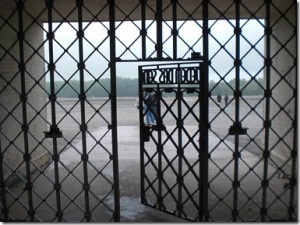
The front gate at Buchenwald, from the inside looking out, that Wiesel says he marched right up to “tens of times” but was always turned back!
- Liberation brings Freedom and Revenge
UdV, P 244: The first gesture of freedom: the starved men made an effort to get something to eat. They only thought about food. Not about revenge. Not about their parents. Only about bread. And even when they had satisfied their hunger—they still did not think about revenge.
SR, P 115: Our first act as free men was to throw ourselves onto the provisions. We thought only of that. Not of revenge, not of our families. Nothing but bread.
Oprah Winfrey interview: Oprah asks, “After you were liberated, what did you do?” Wiesel answers: “The first thing many of us did was reassemble to say a prayer for the dead.” (page 5)
* * * *
UdV, P 244: Early the next day Jewish boys ran off to Weimar to steal clothing and potatoes. And to rape German girls [un tsu fargvaldikn daytshe shikses]. The historical commandment of revenge was not fulfilled.
LN, P 178: Le lendemain, quelques jeunes gens coururent à Weimar ramasser des pommes de terre et des habits—et coucher avec des filles. Mais de vengeance, pas trace.
SR, P 116: On the following day, some of the young men went to Weimar to get some potatoes and clothes—and to sleep with girls. But of revenge, not a sign.
MW, P115: The next day a few of the young men ran into Weimar to bring back some potatoes and clothes—and to sleep with girls. But still no trace of revenge.
In this case, Wiesel made the change from ‘rape’ to ‘sleep with’ in La Nuit. The expression for “German girls” that we find in the Yiddish book was also removed. The term that was actually used is shikses, a word which originally meant “abomination” and which is used today as a term of contempt for all non-Jewish women. In other words, in saying daytshe shikses, the author was expressing, in rather vulgar terms, his contempt and hatred for German women. This apparently was not good for the eyes of the Goyim to see. It was changed by Wiesel in the French La Nuit, and thus it never reached our eyes until now.
Yet, the Yiddish author goes even further and decries the failure of the Jewish males to take a proper revenge, which is here envisioned as a much larger public act of retribution than the “too mild” raping of German women. (Public retribution, of course, did come later with the Nuremberg Military Tribunals.)
Eliezer is hospitalized for two weeks—April 14 to April 28
UdV P 244: Three days after liberation I became very ill; food-poisoning. They took me to the hospital and the doctors said that I was gone. For two weeks I lay in the hospital between life and death. My situation grew worse from day to day.
SR P 116: Three days after the liberation I became very ill with food poisoning. I was transferred to the hospital and spent two weeks between life and death.
MW P 115: Three days after the liberation of Buchenwald, I became very ill: some form of poisoning. I was transferred to a hospital and spent two weeks between life and death.
Three days after liberation on April 11th is April 14th. Thus, Eliezer is in the hospital from April 14 until April 28—extremely ill, close to death. In his 1995 memoir, All Rivers Run to the Sea, Elie Wiesel claims that on that day (the 14th) he was thrown a can of lard, which he apparently ate although he doesn’t remember doing so. He lost consciousness and awoke in a hospital. But the addition of this story, which is in the original Un di velt, presents serious problems for Elie Wiesel. Perhaps the hospital story had slipped his mind when he decided to claim he was one of the survivors lying on a bunk in the “famous Buchenwald liberation photograph.” Because he was in the hospital …
He cannot be in the famous Buchenwald liberation photo taken on April 16 …
I have already demolished the false claim that Wiesel is in that photograph here. But on top of that, our translator found an interview of Leo Eitinger, a Jewish Czech-born psychiatrist, by Harry James Cargas, a friend and biographer of Elie Wiesel, which contained this gem:
HJC: The same thing happened with Livia Rothkirchen at Yad Vashem as happened with you. I was there doing research on atrocity photography for my book A Christian Response to the Holocaust and saw a photo that covers a large wall, of seventeen men lying in their bunks at liberation time. I think you’ve probably seen this picture. Wiesel and Dr. Rothkirchen passed it by many times, over a several-year period, before he told her he was in that photograph. I asked Elie if I could write something about it and he said, “No.” I wrote something and showed it to him and he gave me permission to publish it.
The photo at Yad Vashem in Israel with Elie Wiesel posing in front of it in 1986 after receiving the Nobel Peace Prize in Oslo.
LE: I didn’t know Elie is in the photo.4
Cargas’ book was published in 1993, ten years after it was publicly announced that Elie Wiesel was in that photograph. Apart from the revelation that Cargas has to ask permission from Wiesel before he publishes anything about him, can you imagine that after walking by that famous photo for several years, Wiesel would finally think to say, “Oh hey, that’s me laying there, back in the shadows.”
He cannot have been present to agree to and sign the Military Questionaire on April 22 …
Much has been made by holocaust historians like Kenneth Waltzer and others I won’t name that this Fragebogen made out for Lázár Wiesel proves that Elie Wiesel was in Buchenwald. The birth date is not Elie’s; the date of arrest is not Elie’s; the signature is not Elie’s; the registration number belongs to another prisoner (Pavel Kun) who died only a month earlier; and on top of all that … Elie himself tells us in Night that he was lingering between life and death in the hospital on April 22. He was still six days away from having recovered enough to leave the hospital.
He cannot be in the photograph of the “Boys of Buchenwald” taken on April 27.
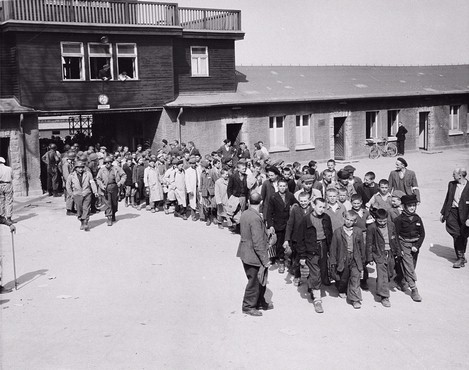 Kenneth Waltzer also claims on his Michigan State University website that Elie Wiesel is “seen to the left” (short boy fourth from the front in left row wearing dark suit in front of the taller boy wearing a beret) in this photograph of the youths being transferred from the barracks inside Buchenwald to the former SS barracks on the outside. Why is Waltzer not paying attention to what is written in Night — that Eliezer was put in the hospital on the 14th of April, at death’s door, and remained for two weeks? One really has to wonder at the stupidity of holocaust historians. Or more likely — how stupid they think the rest of us are! See The Many Faces of Elie Wiesel.
Kenneth Waltzer also claims on his Michigan State University website that Elie Wiesel is “seen to the left” (short boy fourth from the front in left row wearing dark suit in front of the taller boy wearing a beret) in this photograph of the youths being transferred from the barracks inside Buchenwald to the former SS barracks on the outside. Why is Waltzer not paying attention to what is written in Night — that Eliezer was put in the hospital on the 14th of April, at death’s door, and remained for two weeks? One really has to wonder at the stupidity of holocaust historians. Or more likely — how stupid they think the rest of us are! See The Many Faces of Elie Wiesel.
The book’s ending: What does the long passage in Un di velt hot geshvign tell us?
UdV P 245: One fine day I got up—with the last of my energy—and went over to the mirror that was hanging on the wall. I wanted to see myself. I had not seen myself since the ghetto.
From the mirror a skeleton gazed out.
Skin and bones.
I saw the image of myself after my death. It was at that instant that the will to live was awakened.
Without knowing why, I raised a balled-up fist and smashed the mirror, breaking the image that lived within it.
And then—I fainted.
From that moment on my health began to improve.
I stayed in bed for a few more days, in the course of which I wrote the outline of the book you are holding in your hand, dear reader.
But—
Now, ten years after Buchenwald, I see that the world is forgetting. Germany is a sovereign state, the German army has been reborn. The bestial sadist of Buchenwald, Ilsa Koch, is happily raising her children. War criminals stroll in the streets of Hamburg and Munich. The past has been erased. Forgotten.
Germans and antisemites persuade the world that the story of the six million Jewish martyrs is a fantasy, and the naive world will probably believe them, if not today, then tomorrow or the next day.
So I thought it would be a good idea to publish a book based on the notes I wrote in Buchenwald.
I am not so naive to believe that this book will change history or shake people’s beliefs. Books no longer have the power they once had. Those who were silent yesterday will also be silent tomorrow. I often ask myself, now, ten years after Buchenwald:
Was it worth breaking that mirror? Was it worth it?
SR P 116: One day I was able to get up, after gathering all my strength. I wanted to see myself in the mirror hanging on the opposite wall. I had not seen myself since the ghetto.
From the depths of the mirror, a corpse gazed back at me.
The look in his eyes, as they stared into mine, has never left me.
MW P 115: One day when I was able to get up, I decided to look at myself in the mirror on the opposite wall. I had not seen myself since the ghetto.
From the depths of the mirror, a corpse was contemplating me.
The look in his eyes as he as he gazed at me has never left me.
The difference in length between the Yiddish and the English passage is the first thing that strikes us. The Yiddish writer had a lot to say in these final thoughts. He regained his “will to live” right there in the hospital. Twice he speaks of writing an outline and notes for Un di velt hot geshvign while still in his hospital bed. But there is no record by Elie Wiesel anywhere that says he did any writing in preparation for writing his “testimony” while in the camp (in fact, just the opposite), or at any time in advance of 1954.
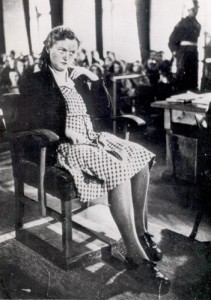
Ilse Koch on the witness stand in 1947. She was seven months pregnant and the only woman brought before the American Military Tribunals held at Dachau.
The tragic true story of Ilse Koch is that she gave birth to one child while a prisoner of the Americans but she certainly was not allowed to raise him. She was hounded, vilified and persecuted after the war, retried by a German court in 1951 after being acquitted at the IMT, and ultimately given a life sentence—solely, it can be argued, to satisfy Jewish vengeance. She committed suicide in prison in 1967.
The Yiddish author also mentions the “six million Jewish martyrs” … in 1954. This number emerged from the Nuremberg Tribunals, but we know that claims of “six million Jewish victims” goes all the way back to the 1890’s.
All this and more was cut out for the French La Nuit (which, remember, was written by Wiesel) and the English versions which were taken from the French. As has been noted by Jewish commentators themselves, the Yiddish writer is an angry, politically-minded religious Jew who expected, or wished, the world to have been transformed by the travail of the Jews during WWII. He is bitterly disappointed. There is more in this final chapter of the Yiddish book that doesn’t appear in the French or English versions. Here is just one passage:
Dreams of truth, of freedom are false dreams for men. Visions of justice and equality are false visions for men. Man is: the struggle for bread, for meat; man is: the struggle to satisfy one’s own instincts.
Man is instinct to the core. Flesh to the core. And not heart. And not spirit. And not morality.
I learned that in Buchenwald. And what one learns in such conditions is without a doubt the truth, the purest truth. For man can really know man only in extreme conditions, when he has thrown away from himself all masks, social and psychological, and appears before us naked, as he is in truth.
In Buchenwald I saw the true face of man. The face of a human animal, which is worse than a true animal. O God, woe is you, woe is man, how trifling and puny. Ought you to even exist, if the son of Adam was made in your image!
God . . . I had ceased to believe in his existence. But despite that, I continued to believe in his evil. (UdV, P 240-41)
Was this written by Elie Wiesel? If it was, he is a man who has put on his own mask to play the game of Jewish vengeance against the goyim persecutors of his people. In other parts of Night, Wiesel writes of losing his faith in a caring God, of no longer following his religion—but later he denied that is true, even though he wrote it! But this passage in Un di velt is too passionate to dismiss as merely a passing sense of discouragement. That is, of course, unless it is just a literary construct and doesn’t reflect any truth of the author.
What does it all mean?
The title of this two-part article is “What Changes were made to Elie Wiesel’s Night, and Why.” I didn’t promise to solve the mystery of the author of Un di velt hot geshvign, but I did hope I might do so, or at least eliminate some contenders.
I confess I expected there to be more difference between the Yiddish and the French books than it turns out to be. It is now clear that La Nuit was taken directly from Un di velt, although that doesn’t mean they were written by the same person. However, that is the greater likelihood unless it can be proven otherwise. Similarly, if Elie Wiesel is the author of Un di velt, it doesn’t mean he was in the camps. The fact that the books are filled with errors argues against it.
Night is a novel
It’s difficult to come to any certainties when the material we have to work with is so internally inconsistent and when there are several versions of it—similar in some ways to the many versions of the Anne Frank Diary. But we can conclude for certain that Night only works as a novel, not as an autobiography—no matter how much the Jewish spin doctors say that a memoir, to be a work of “great literature,” must include some fictional flights of fancy. Nowhere does Night fit the facts. Even with wife Marion’s changes in 2006, it couldn’t be pulled together enough to make a convincing true-life testimony. And we know how many of these “survivor novels” there are around. It’s not like many other hopefuls didn’t have the same idea!
The Lazar-Lázár Riddle
In spite of all the above, I would like to propose a hypothetical scenario, one that I am not endorsing, for obvious reasons, but that does have the value of answering one of the more ignored aspects of this riddle, namely the way the 32-year-old Lazar Wiesel disappeared at the same time the 16-year-old Lázár Wiesel appeared. This cannot be denied. Thirty-one-year-old Lazar arrived at Buchenwald in January; sixteen-year-old Lázár left there in July. The easiest explanation for this is that Lazar wanted to have the papers of a 16-year-old Buchenwald orphan so he could be sent to France. In the confusion of the last months of the war and the immediate post-war period, this kind of thing became more possible. Such an explanation may sound a little far-fetched, but is it any harder to swallow than Elie Wiesel not having the tattoo (Auschwitz ID number) that he says he has? Or Elie Wiesel not having his own Buchenwald identification number, but “borrowing” a dead man’s (Pavel Kun, 2 years older than Elie) right before, or after, liberation? These things don’t make sense. Nor does the fact that in La Nuit Elie Wiesel wrote that his father died on Jan. 28, 1945, while in the Yiddish book that he also claims to have written as his own “testimony” the date is Feb. 2nd? Or that he wrote that the Russian Army took over the Auschwitz complex two days after its evacuation, which everyone knows is false?
Elie Wiesel even wrote in Night that his foot was operated on right before the evacuation of Auschwitz, while in his later real memoir, All Rivers Run to the Sea (pp 89-90), he flat-out recalled it as his knee, something that could not be mis-remembered. I could list many of these senseless “mistakes,” many of which I have written about in earlier articles.
There is something that doesn’t fit well into this Lazar-Lázár hypothesis, though—that is, that we have pictures of the real Elie Wiesel in France at the Jewish welfare orphanage, OSE. But how did he get through a year at Auschwitz and Buchenwald with no records of his being there … and a poor memory of what occurred and when? Did he somehow manage to attach himself to the Buchenwald transport with the stolen identity papers? But also, there are other ways he could have come to be at the Ecouis homes in France than in the children’s transport from Buchenwald. Just as there are other ways he could have come into possession of the Yiddish Un di velt without writing it himself.
Was Elie Wiesel in the camps?
My answer is still no. Wiesel could have been in some camps in some capacity under some auspices, but he is not telling the truth about what camp experience he did have. That means Hilda Wiesel Kudler is also not telling the truth but is standing by her brother. She says at the end of her bitter testimony to the Shoah Foundation, “I will not forget, and I will not forgive.” Have you ever wondered why Elie has not contributed a videotaped testimony to the Spielberg/USC Shoah Foundation library?
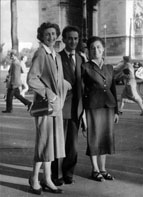
Elie Wiesel with his older sisters Bea (left) and Hilda (right) in Paris after the war, exact date unknown.
Wiesel’s other sister, who changed her name to Beatrice from Batia, never wrote or testified a word about it. She did go to work for Jewish organizations in Germany, however, immediately after the war, helping Jews to emigrate to wherever they wanted to go, including Palestine. The whole family were committed Zionists, as were most Eastern European/Russian Jews who were able to flood into the West because of the war. ‘Bea’ finally got her own papers to emigrate to Canada.
A Jewish organization, Sharit Ha-Platah, gathered names of Jews who were liberated from Dachau and it’s many sub-camps and published them in 1946. This is the only record so far found with the names of Hilda and Beatrice Wiesel, and it is a self-identified list of Jews by Jews, not an official German record of forced laborers or prisoners. So the hard evidence for the Wiesel family is not there. It doesn’t mean they weren’t, however; it’s just that we’re left with believing what they say, because we want to or because we’re expected to.
The easiest option is to go along with Elie Wiesel’s story that he was in those camps, and question his credibility from other angles, such as the in-credible stories he tells. This is what revisionists had done before Nikolaus Grüner came along and released documents he had obtained from Buchenwald and the correspondence he had with the archivists there. These documents cannot be ignored, in spite of what other nonsense Grüner writes in his book Stolen Identity. These documents have caused a sea change in revisionism about Elie Wiesel, to the extent that it can be divided between pre-Grüner and post-Grüner research and writing.
Wiesel needs to expose himself to questions
Because of these documents, it is up to Elie Wiesel to come forth and answer questions about them. But being that he is completely unprepared to do so, this job has been given to his surrogates—Professor Waltzer for one. Kenneth Waltzer promised, with a lot of bombast, that he would produce proof that Elie is Lazar and that Shlomo is Abraham, but for a year now he has failed to produce it, or even say anything more about it. He has also failed to come out with his promised book, “The Rescue of Children and Youths at Buchenwald,” which was to include Elie Wiesel. In the opinion of this writer, Waltzer is as big a fraud as Wiesel, selling emotion and sentimentality instead of factual history. They are both supported with professorships at well-funded universities.
So, back to the main question: Was Elie Wiesel in Auschwitz and Buchenwald? As I said, my answer is still no … and no one should accept that he was without some further explanation from him, during which he subjects himself to questions. If he’s genuine, he can certainly withstand questions. That, however, is not going to happen because … fill in your own answer.
Elie Wiesel has kept the details of his life before 1955 vague. He has managed to prevent unwanted questions from being asked of him. He hides behind a stated aversion to “holocaust deniers” so that anyone who is not a 100% believer is not welcome in his company. He gets away with the ‘moral outrage’ he professes toward anyone who doubts, thus no interviewer, reporter, writer, academic, student or even President dares to doubt in his presence. It works like a charm.
Endnotes
1. Danuta Czech, Auschwitz Chronicle: 1939-1945. New York: Henry Holt, 1997
2. APMO, D-Bu 3/17, pp. 18-85, 87 (transport list as cited by Czech in Auschwitz Chronicle)
3. Hilda was obviously unaware that the march itself was only 24 hours, probably because she had heard so many false and exaggerated stories about “endless days of marching” that proliferate in survivor stories.
4. Harry James Cargas, ed. Voices from the Holocaust, Lexington: University of Kentucky Press, 1993. pp. 116-22.
Category Featured | Tags: Tags: Auschwitz-Birkenau, Buchenwald, Elie Wiesel, Hilda Wiesel, Holocaust fraud, Miklos Grüner, Night, Shlomo Wiesel, Un di velt holt geshvign,
Social Networks: Facebook, Twitter, Google Bookmarks, del.icio.us, StumbleUpon, Digg, Reddit, Posterous.

